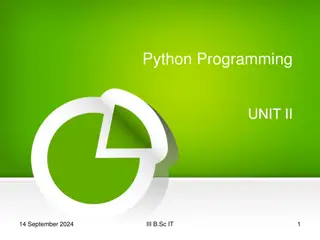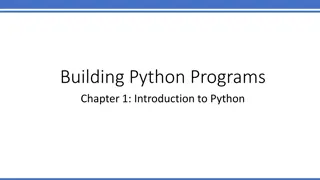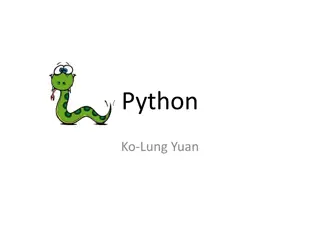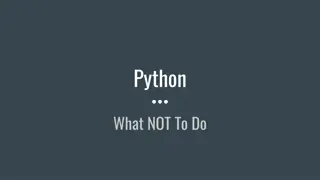Python Programming: Overview and Benefits
Python is an open-source programming language known for its simplicity, versatility, and powerful capabilities. Developed in the late '80s, Python is widely used by major tech companies and offers extensive libraries for various applications. It is cross-platform, making it accessible to users on Linux, Windows, Mac, and even mobile devices. Python is ideal for scripting, rapid application development, system administration tasks, and is great for encouraging children to start programming.
Download Presentation

Please find below an Image/Link to download the presentation.
The content on the website is provided AS IS for your information and personal use only. It may not be sold, licensed, or shared on other websites without obtaining consent from the author.If you encounter any issues during the download, it is possible that the publisher has removed the file from their server.
You are allowed to download the files provided on this website for personal or commercial use, subject to the condition that they are used lawfully. All files are the property of their respective owners.
The content on the website is provided AS IS for your information and personal use only. It may not be sold, licensed, or shared on other websites without obtaining consent from the author.
E N D
Presentation Transcript
Hacking Techniques & Intrusion Detection Ali Al-Shemery (aka: B!n@ry) arabnix at gmail dot com
All materials is licensed under a Creative Commons Share Alike license. http://creativecommons.org/licenses/by-sa/3.0/ 2
Writing Basic Security Tools using Python Special lecture
>>> import antigravity Cited [1]
Cited [2]
Outline About Python Python Basics Types Controls Python Functions and Modules Python Tips and Tricks Coding for Penetration Testers 6 binary-zone.com 6
About Python Python is an open source programming language. Development started by Guido van Rossum in December 1989. Conceived in the late 1980 s Python 2.0 was release on October 16th, 2000 Python 3.0 was released on December 2008 Name came from TV series Monty Python s Flying Circus . binary-zone.com 7
About Python Cont. Python is cross platform Linux (shipped out of the box) Windows (easy to install) Mac Even work on your Droid! etc binary-zone.com 8
Why Learn Python? Lot of people always ask me Why learn Python ? The answer is simple: Simple and easy to learn Free and Open Source Powerful high-level programming language Widely used (Google, NASA, Yahoo, etc) Portable HUGE number of Extensive Libraries! binary-zone.com 9
What is Python Good for? Ideal language for scripting and rapid application development in many areas on most platforms. All computer related subjects (IMO except system programming) Performing System Administration Tasks Encouraging and Helping Children start programming binary-zone.com 10
What About Security? Extensive use in the information security industry Exploit Development Networking Debugging Encryption/Decription Reverse Engineering Fuzzing Web Forensics Malware analysis Cited [2] binary-zone.com 11
Let s Start Working Interactive Interpreter Text Editors Vim, Nano, Geany (was my favorite), PyCharm (favorite), Gedit, Kate, Notepad++, etc binary-zone.com 12
Python Basics Integers (int) >>> httpPort=80 >>> Subnet=24 Floating Point (float) >>> 5.2/2 2.6 Strings (str) >>> url= http://www.linuxac.org/ binary-zone.com 13
Playing with Strings One of the most powerful capabilities of Python String Slicing >>> logFile= /var/log/messages >>> logFile[0] / >>> logFile[1:4] var >>> logFile[-8:] 'messages' >>> logFile.split("/") ['', 'var', 'log', 'messages'] binary-zone.com 14
Playing with Strings Cont. String Concatenation >>> userName = ali >>> domainName = ashemery.com >>> userEmail = userName + @ + domainName >>> userEmail 'ali@ashemery.com >>> website="http://www.ashemery.com/" >>> param="?p=123" >>> url = "".join([website,param]) >>> url 'http://www.ashemery.com/?p=123' binary-zone.com 15
Python Lists Python lists are very useful when you have a collection of elements >>> portList = [21,22,25,80] >>> portList[0] 21 >>> portList.insert(1,22) >>> portList [21, 22, 25, 80, 443] >>> portList.append(443) >>> portList [21, 22, 25, 80, 443] >>> portList = [] >>> portList [] Lists in Python can be of any mixed type, variables!!! >>> portList.remove(22) >>> portList [21, 25, 80, 443] even list of binary-zone.com 16
Python Controls - Decisions IF, ELSE, and ELIF Statements >>> pList = [21,22,25,80] >>> if pList[0] == 21: ... print("FTP Service") ... elif pList[0] == 22: ... print("SSH Service") ... else: ... print("Unknown Service") ... FTP Important NOTE: Python doesn t use line terminators (ex: semicolons), but Python forces you to use indents Ensures writing elegant code! binary-zone.com 17
Python Controls - Loops For and While Statements >>> for port in pList: ... print "This is port : ", port ... This is port : 21 This is port : 22 This is port : 25 This is port : 80 binary-zone.com 18
Python Tips and Tricks Changing and checking data types >>> httpPort=80 >>> httpPort 80 >>> type(httpPort) <type 'int'> >>> httpPort = str(httpPort) >>> type(httpPort) <type 'str'> >>> httpPort '80 binary-zone.com 19
Python Tips and Tricks Cont. Getting the length of an object >>> len(pList) 4 String formatting >>> pList = [21,22,25,80] >>> for member in pList: ... print "This is port number %d" % member ... This is port number 21 This is port number 22 This is port number 25 This is port number 80 binary-zone.com 20
Python Tips and Tricks Cont. Another String formatting example >>> ip = "192.168.1.1" >>> mac = "AA:BB:CC:DD:EE:FF" >>> print "The gateway has the following IP: %s and MAC: %s addresses" % (ip, mac) The gateway has the following IP: 192.168.1.1 and MAC: AA:BB:CC:DD:EE:FF addresses binary-zone.com 21
Python Tips and Tricks Cont. Working with ASCII codes >>> x = '\x41 >>> print x A Converting to Hexadecimals >>> hex(255) '0xff' >>> hex(0) '0x0' >>> hex(10) '0xa' >>> hex(15) '0xf' binary-zone.com 22
Python User Input Python can handle user input from different sources: Directly from the user From Files From GUI (not covered in this lecture) binary-zone.com 23
Python User Input Cont. Directly from the user using raw_input >>> userEmail = raw_input("Please enter your email address: ") Please enter your email address: ali@ashemery.com >>> userEmail 'ali@ashemery.com' >>> type(userEmail) <type 'str'> binary-zone.com 24
Python User Input Cont. From Text Files >>> f = open("./services.txt", "r") >>> for line in f: ... print line ... HTTP 80 SSH 22 FTP 21 HTTPS 443 SMTP 25 POP 110 Other common file functions: write read readline >>> f.close() binary-zone.com 25
Creating Functions Whenever you need to repeat a block of code, functions comes helpful Creating a Python Function (syntax) def fName( listOfArguments ): Line1 Line2 . Line n return something binary-zone.com 26
Creating Functions Cont. Basic function to check for valid port numbers def checkPortNumber(port): if port > 65535 or port < 0: return False else: return True Howto use the checkPortNumber function: print checkPortNumber(80) True print checkPortNumber(66000) False print checkPortNumber(-1) False binary-zone.com 27
Working with Modules Modules in Python are simply any file containing Python statements! Python is distributed with many modules To use a module: import module import module1, module2, moduleN import module as newname from module import * from module import <specific> binary-zone.com 28
Common Used Modules The most commonly used modules with security coding are: string, re os, sys, socket hashlib httplib, urllib2 Others? Please add binary-zone.com 29
Module sys Check Python path, and count them import sys print "path has", len(sys.path), "members print "The members are: for member in sys.path: print member Print all imported modules: >>> print sys.modules.keys() Print the platform type (linux, win32, mac, etc) >>> print sys.platform binary-zone.com 31
Module sys Cont. Check application name, and list number of passed arguments import sys print The application name is:", sys.argv[0] if len(sys.argv) > 1: print You passed", len(sys.argv)-1, "arguments. They are:" for arg in sys.argv[1:]: print arg else: print No arguments passed! binary-zone.com 32
Module sys Cont. Check the Python working version >>> sys.version binary-zone.com 33
Module os import os Check platform name (UNIX/Linux = posix, Windows = nt): >>> os.name Print the current working directory >>> os.getcwd() List files in specific directory fList = os.listdir("/home") for f in fList: print f binary-zone.com 34
Module os Cont. Remove a file (delete) >>> os.remove( file.txt") Check the platform line terminator (Windows = \r\n , Linux = \n , Mac = \r ) >>> os.linesep Get the effective UID for current user >>> os.geteuid() Check if file and check if directory >>> os.path.isfile("/tmp") >>> os.path.isdir("/tmp") binary-zone.com 35
Module os Cont. Run a shell command >>> os.system("ping -c 2 127.0.0.1") Execute a command & return a file object files = os.popen("ls -l /tmp") for i in files: print i binary-zone.com 36
Module os Cont. os.system() os.stat() os.environ() os.chdir() os.getcwd() os.getgid() os.getuid() os.getpid() os.getlogin() os.access() os.chmod() os.chown() os.umask(mask) os.getsize() # Executing a shell command # Get the status of a file # Get the users environment # Move focus to a different directory # Returns the current working directory # Return the real group id of the current process # Return the current process s user id # Returns the real process ID of the current process # Return the name of the user logged # Check read permissions # Change the mode of path to the numeric mode # Change the owner and group id # Set the current numeric umask # Get the size of a file binary-zone.com 37
Module os Cont. os.path.getmtime() # Last time a given directory was modified os.path.getatime() # Last time a given directory was accessed os.environ() # Get the users environment os.uname() # Return information about the current OS os.chroot(path) # Change the root directory of the current process to path os.listdir(path) os.getloadavg() # List of the entries in the directory given by path # Show queue averaged over the last 1, 5, and 15 minutes os.path.exists() os.walk() # Check if a path exists # Print out all directories, sub-directories and files binary-zone.com 38
Module os Cont. os.mkdir(path) # Create a directory named path with numeric mode mode os.makedirs(path) os.remove(path) os.removedirs(path) os.rename(src, dst) os.rmdir(path) # Recursive directory creation function # Remove (delete) the file path # Remove directories recursively # Rename the file or directory src to dst # Remove (delete) the directory path binary-zone.com 39
Execute External Programs Running external programs are very useful when you need to do automation (like in scripts) Execution could be categorized into: Synchronous Invokes the external commands and waits for the return Asynchronous Returns immediately and continue in the main thread http://helloacm.com/execute-external-programs-the-python-ways/ binary-zone.com 40
Execute External Programs Cont. The easy was is to import the os module Provides: popen(), system(), startfile() >>> import os >>> print os.popen("echo Hello, World!").read() The os.popen() will treat the output (stdout, stderr) as file object, so you can capture the output of the external programs binary-zone.com 41
Execute External Programs Cont. The os.system() is also synchronous, and could returns the exit-status >>> import os >>> print os.system('notepad.exe') binary-zone.com 42
Execute External Programs Cont. By acting like double-click in the file explorer, you can use os.startfile() to launch external program that is associated with this file This is an asynchronous method >>> import os >>> os.startfile('test.txt') It will throw out an exception if file is not found WindowsError: [Error 2] The system cannot find the file specified: binary-zone.com 43
Execute External Programs Cont. If you install the win32api package (not shipped by default), you can use the following asynchronous method: import win32api try: win32api.WinExec('notepad.exe') except: pass Windows platforms only. binary-zone.com 44
Execute External Programs Cont. The subprocess package provides a syncrhonous and an asynchronous methods namely call and Popen Both methods take the first parameter as a list import subprocess subprocess.call(['notepad.exe', 'abc.txt']) subprocess.Popen(['notepad.exe']) # thread continues ... p.terminate() binary-zone.com 45
Execute External Programs Cont. You can use wait() to synchronous the processes import subprocess p = subprocess.Popen('ls', shell=True, stdout=subprocess.PIPE, stderr=subprocess.STDOUT) for line in p.stdout.readlines(): print line retval = p.wait() print retval binary-zone.com 46
Module socket import socket Creating a simple TCP client Check simpleClient.py Creating a simple TCP server Check simpleServer.py Create a malicious FTP Client ftpClient.py binary-zone.com 47
Module socket Cont. Create TCP Socket, then send and receive data from website using the socket import socket s = socket.socket(socket.AF_INET, socket.SOCK_STREAM) s.connect(("www.ashemery.com", 80)) s.send('GET / HTTP/1.1\r\nHost: www.ashemery.com\r\n\r\n') data = s.recv(2048) s.close() print data Note: For UDP Sockets use SOCK_DGRAM instead of SOCK_STREAM binary-zone.com 48
Module pcapy Pcapy is a Python extension module that interfaces with the libpcap packet capture library. Pcapy enables python scripts to capture packets on the network. Pcapy is highly effective when used in conjunction with a packet-handling package such as Impacket, which is a collection of Python classes for constructing and dissecting network packets. Packet Capturing using pcapy example pcapyPktCapture1.py pcapyEx1.py pcapyDumper.py binary-zone.com 49
Module urllib & urllib2 urllib2 is a Python module for fetching URLs. Offers a very simple interface, in the form of the urlopen function. Capable of fetching URLs using a variety of different protocols (http, ftp, file, etc) Also offers a slightly more complex interface for handling common situations: Basic authentication Cookies Proxies etc binary-zone.com 50























